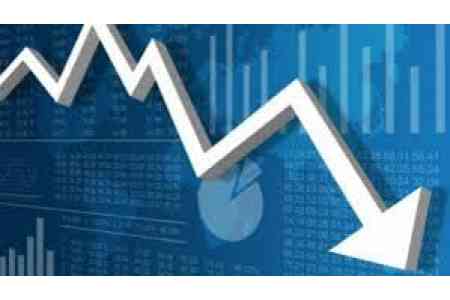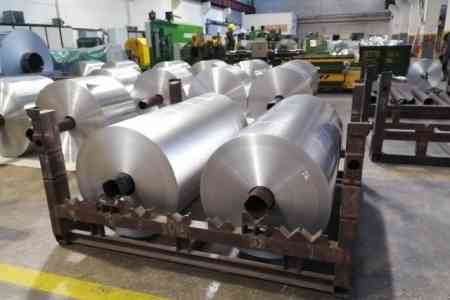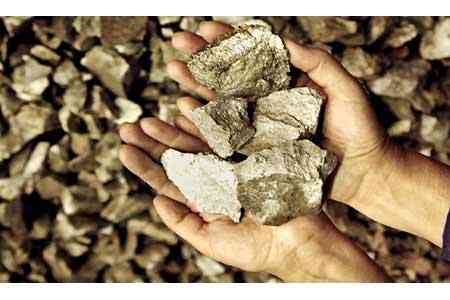 During 2024, the Armenian government returned about $1 billion to taxpayers - Pashinyan During 2024, the Armenian government returned about $1 billion to taxpayers - Pashinyan |
 SRC Head: 4,451 individuals reported their income to the Armenian tax authority for 2024 SRC Head: 4,451 individuals reported their income to the Armenian tax authority for 2024 |
 Armenia`s metallurgical industry closed 2024 in the black Armenia`s metallurgical industry closed 2024 in the black |
 In 2024, Armenia`s economic activity growth rate slowed down from 9.4% to 8% In 2024, Armenia`s economic activity growth rate slowed down from 9.4% to 8% |
 Armenia joins ECAC initiative on cooperation and exchange of experience in the field of accident investigation in civil aviation Armenia joins ECAC initiative on cooperation and exchange of experience in the field of accident investigation in civil aviation |
 Armenian authorities strangling SMEs with new tax duties - protest in Yerevan Armenian authorities strangling SMEs with new tax duties - protest in Yerevan |
 The gambling industry in Armenia will be subject to a 10% turnover tax in addition to current taxes and duties The gambling industry in Armenia will be subject to a 10% turnover tax in addition to current taxes and duties |
 Global economy takes wait-and-see attitude - Amundi Global economy takes wait-and-see attitude - Amundi |
 Vine and Wine Foundation of Armenia promoting Armenian wines in Japanese market Vine and Wine Foundation of Armenia promoting Armenian wines in Japanese market |
 Armenian authorities to extend tax breaks for private companies issuing their bonds Armenian authorities to extend tax breaks for private companies issuing their bonds |
 Armenia, India discuss simplified visa requirements Armenia, India discuss simplified visa requirements |
 Interest rates remain stable due to high demand for consumer and mortgage loans Interest rates remain stable due to high demand for consumer and mortgage loans |
 Central Bank Governor: Business lending growth in 2024 will help us achieve economic activity level projected for 2025 Central Bank Governor: Business lending growth in 2024 will help us achieve economic activity level projected for 2025 |
 Martin Galstyan: Economic activity in Armenia is weakening and labor market development prospects are too uncertain Martin Galstyan: Economic activity in Armenia is weakening and labor market development prospects are too uncertain |
 In January 2025, Armenia`s state treasury revenues increased by 40.3% compared to January 2024 In January 2025, Armenia`s state treasury revenues increased by 40.3% compared to January 2024 |
 Italian Trade and Investment Agency to establish presence in Armenia Italian Trade and Investment Agency to establish presence in Armenia |
 Armenia`s GDP growth in 2024 will be significantly lower than in 2023 - Luys Foundation Armenia`s GDP growth in 2024 will be significantly lower than in 2023 - Luys Foundation |
 Armenia`s Union of Employers urges ZCMC employees to engage in constructive negotiations Armenia`s Union of Employers urges ZCMC employees to engage in constructive negotiations |
 In 2024, Armenia increased its public debt by almost $1 billion In 2024, Armenia increased its public debt by almost $1 billion |
 Armenian CB reduces refinancing rate to 6.75% Armenian CB reduces refinancing rate to 6.75% |
 Lawyers start protest against Bar taxation Lawyers start protest against Bar taxation |
 Amundi expects 2-digit growth in almost all markets Amundi expects 2-digit growth in almost all markets |
 Armenia, Czech Republic discuss cooperation in the field of solid waste processing Armenia, Czech Republic discuss cooperation in the field of solid waste processing |
 ArmInfo released its 30th bulletin "Armenian banks in the card business" ArmInfo released its 30th bulletin "Armenian banks in the card business" |
 New IDBank Branch in Armavir New IDBank Branch in Armavir |
 "Amundi Investment Outlook 2025": Bright spots in a world of irregularities "Amundi Investment Outlook 2025": Bright spots in a world of irregularities |
 Pay with IDBank Mastercard and get 5% idcoin Pay with IDBank Mastercard and get 5% idcoin |
 RA Finance Minister discusses Armenia`s tax policy with Joseph Stiglitz RA Finance Minister discusses Armenia`s tax policy with Joseph Stiglitz |
 EIB Global granting a EUR 105 million loan to Ameriabank to support Armenian private sector EIB Global granting a EUR 105 million loan to Ameriabank to support Armenian private sector |
 In 2024, "gray deals" involving gold and diamonds with Hong Kong, the UAE and several offshore zones began to shine through in private transfers In 2024, "gray deals" involving gold and diamonds with Hong Kong, the UAE and several offshore zones began to shine through in private transfers |
 900,000 people to file reports on 2024 incomes 900,000 people to file reports on 2024 incomes |
 Problems involving EU limits on import limits on carbon-intensive products Problems involving EU limits on import limits on carbon-intensive products |
 State Control Service to control expenditure of public funds State Control Service to control expenditure of public funds |
 ZCMC to hold instigators responsible - statement ZCMC to hold instigators responsible - statement |
 Armenal plant gets new director Armenal plant gets new director |
 Armenia`s gross international reserves $3.7bln by 2024 end Armenia`s gross international reserves $3.7bln by 2024 end |
 ZCMC CJSC management rejects demand for unrealistic salary increase ZCMC CJSC management rejects demand for unrealistic salary increase |
 Severing Yerevan-Moscow economic ties could destabilize Armenia - report Severing Yerevan-Moscow economic ties could destabilize Armenia - report |
 Armenia`s minister of economy highlights Modus Granum company`s role in Armenia`s agricultural sector Armenia`s minister of economy highlights Modus Granum company`s role in Armenia`s agricultural sector |
 Armenia hopes for new victories World Tasting Contest - minister Armenia hopes for new victories World Tasting Contest - minister |
 Armenia, Iran discussing administrative assistance mechanisms in customs, taxation Armenia, Iran discussing administrative assistance mechanisms in customs, taxation |
 Equally active USD, RUB transactions in Armenia`s interbank foreign exchange market Jan. 27-31, 2025 Equally active USD, RUB transactions in Armenia`s interbank foreign exchange market Jan. 27-31, 2025 |
 In Armenia, public sector salaries increasing at a faster rate than those in the private sector In Armenia, public sector salaries increasing at a faster rate than those in the private sector |
 In Armenia, the industrial price index rose from 101.5% to 103.6% in January-December 2024 In Armenia, the industrial price index rose from 101.5% to 103.6% in January-December 2024 |
 Mher Grigoryan: Despite all challenges, we are committed to building an effective union Mher Grigoryan: Despite all challenges, we are committed to building an effective union |
 Zakharova: Armenia`s EAEU membership provides economic benefits that would be forfeited with European integration Zakharova: Armenia`s EAEU membership provides economic benefits that would be forfeited with European integration |
 In Armenia, economic growth slowed from 14.2% to 8% down in the past two years In Armenia, economic growth slowed from 14.2% to 8% down in the past two years |
 We have a good life in the EAEU, but a significant portion of the population is seeking an alternative: RA Prime Minister We have a good life in the EAEU, but a significant portion of the population is seeking an alternative: RA Prime Minister |
 Armenian Deputy Economy Minister, AFD delegation discuss macroeconomic and financial situation in Armenia Armenian Deputy Economy Minister, AFD delegation discuss macroeconomic and financial situation in Armenia |
 Armenian government supporting local processors to access EU and UK markets Armenian government supporting local processors to access EU and UK markets |
 Armenia`s premier elaborates on taxation Armenia`s premier elaborates on taxation |
 Tax control of energy, water companies to be tightened in Armenia Tax control of energy, water companies to be tightened in Armenia |
 Armenia, Germany map out steps to deepen technological cooperation Armenia, Germany map out steps to deepen technological cooperation |
 Molybdenum export strategy developed in Armenia Molybdenum export strategy developed in Armenia |
 The liquidated Ardshinbank OJSC is not related to Ardshinbank CJSC and is not the legal successor of the latter The liquidated Ardshinbank OJSC is not related to Ardshinbank CJSC and is not the legal successor of the latter |
 Armenia`s Central Bank completed Ardshinbank OJSC bankruptcy process after 23 years Armenia`s Central Bank completed Ardshinbank OJSC bankruptcy process after 23 years |
 ZCMC to pay dividends to shareholders based on its performance in 2023 ZCMC to pay dividends to shareholders based on its performance in 2023 |
 Armenia`s Tourism Committee plans to introduce Institute of State Guarantees to protect tourists` interests Armenia`s Tourism Committee plans to introduce Institute of State Guarantees to protect tourists` interests |
 Overchuk: Armenia`s EU accession will result in the country being excluded from the EAEU market Overchuk: Armenia`s EU accession will result in the country being excluded from the EAEU market |
 Nikol Pashinyan not to attend the Eurasian Intergovernmental Council meeting in Kazakhstan Nikol Pashinyan not to attend the Eurasian Intergovernmental Council meeting in Kazakhstan |
| Read more |


 RUB
RUB USD
USD EUR
EUR GBP
GBP CAD
CAD JPY
JPY CNY
CNY CHF
CHF
